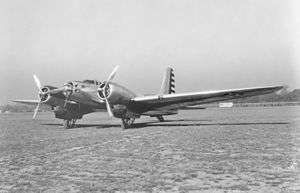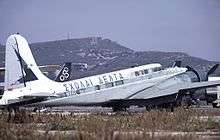Douglas B-23 Dragon
| B-23 Dragon / UC-67 | |
|---|---|
 | |
| A B-23 Dragon in USAAC markings during the early 1940s | |
| Role | Medium bomber |
| National origin | United States |
| Manufacturer | Douglas Aircraft Company |
| First flight | 27 July 1939 |
| Primary user | United States Army Air Corps |
| Number built | 38 |
| Developed from | Douglas B-18 Bolo |
The Douglas B-23 Dragon is an American twin-engined bomber developed by the Douglas Aircraft Company as a successor to (and a refinement of) the B-18 Bolo.
Design and development
Douglas proposed a number of modifications designed to improve the performance of the B-18. Initially considered a redesign, the XB-22 featured 1,600 hp Wright R-2600-1 Twin Cyclone radial engines. The complete B-18 redesign was considered promising enough by the USAAC to alter the original contract to produce the last 38 B-18As ordered under Contract AC9977 as the B-23.[1] The design incorporated a larger wingspan with a wing design very similar to that of the DC-3, a fully retractable undercarriage, and improved defensive armament. The B-23 was the first operational US bomber equipped with a glazed tail gun position.[1] The tail gun was a .50 calibre (12.7 mm) machine gun, which was fired from the prone position by a gunner using a telescopic sight.[2]
The first B-23 flew on July 27, 1939 with the production series of 38 B-23s manufactured between July 1939 and September 1940.
Operational history
While significantly faster and better armed than the B-18, the B-23 was not comparable to newer medium bombers like the North American B-25 Mitchell and Martin B-26 Marauder. For this reason, the 38 B-23s built were never used in combat overseas, although for a brief period they were employed as patrol aircraft stationed on the west coast of the United States.[1] The B-23s were primarily relegated to training duties, although 18 of the type were converted as transports and redesignated UC-67.
The B-23 also served as a testbed for new engines and systems. For example, one was used for turbosupercharger development by General Electric at Schenectady, New York.
After World War II, many examples were used as executive transports, with appropriate internal modifications, and as a result a large number have survived. With its wartime experience with the type, GE bought and used five of them. Howard Hughes (among others) used converted B-23s as personal aircraft.
Operators
Variants
- B-23
- Twin-engined bomber version of the B-18 with modified fuselage, 38 built.
- C-67
- Conversion to utility transport with provision for glider towing, 12 conversions from B-23, redesignated UC-67 in 1943.
- UC-67
- C-67 redesignated in 1943.
Surviving aircraft

.jpg)
Ecuador
- UC-67
On display
- B-23
- 39-0036 - McChord Air Museum in McChord AFB, Washington.[5]
- 39-0051 - Pima Air & Space Museum adjacent to Davis-Monthan Air Force Base in Tucson, Arizona.[6]
- UC-67
- 39-0047 - Castle Air Museum at the former Castle Air Force Base in Atwater, California.[7]
Under restoration or in storage
- B-23
- 39-0033 - to airworthiness by Pissed Away N747M LLC in Bellevue, Washington.[8]
- 39-0037 - in storage at the National Museum of the United States Air Force at Wright-Patterson AFB in Dayton, Ohio.[9]
- 39-0038 - for display at the 1941 Historical Aircraft Group Museum in Geneseo, New York.[10]
- UC-67
- 39-0057 - in storage at Fantasy of Flight in Polk City, Florida.[11]
- 39-0063 - to airworthiness by Carmacks Commercial Corp. in Anchorage, Alaska.[12]
Wrecks
- B-23
Specifications (B-23 Dragon)
Data from McDonnell Douglas Aircraft since 1920[14]
General characteristics
- Crew: Six
- Length: 58 ft 4 3⁄4 in (17.799 m)
- Wingspan: 92 ft 0 in (28.04 m)
- Height: 18 ft 5 1⁄2 in (5.626 m)
- Wing area: 993 sq ft (92.3 m2)
- Empty weight: 19,089 lb (8,659 kg)
- Gross weight: 26,500 lb (12,020 kg)
- Max takeoff weight: 32,400 lb (14,696 kg)
- Powerplant: 2 × Wright R-2600-3 radial engine, 1,600 hp (1,200 kW) each
Performance
- Maximum speed: 282 mph (454 km/h; 245 kn) at 12,000 ft (3,660 m)
- Cruise speed: 210 mph (338 km/h; 182 kn)
- Range: 1,400 mi (1,217 nmi; 2,253 km)
- Service ceiling: 31,600 ft (9,600 m)
- Time to altitude: 6.7 minutes to 10,000 ft (3,050 m)
Armament
- Guns: 3 × .30 in (7.62 mm) machine guns, 1 × .50 in (12.7 mm) machine gun in tail
- Bombs: 2,000 lb (910 kg) in bomb bay
See also
Related development
Aircraft of comparable role, configuration and era
Related lists
References
Notes
- 1 2 3 Mondey 1982, p. 111.
- ↑ "Stinger Gun in Plane's Tail Guards Vulnerable Spot." Popular Science, January 1941.
- ↑ http://www.goodall.com.au/warbirds-directory-v6/douglas.pdf
- ↑ "UC-67 Dragon/39-031" aviationmuseum.eu Retrieved: 15 July 2013.
- ↑ "B-23 Dragon/39-0036." McChord Air Museum. Retrieved: 31 May 2011.
- ↑ "B-23 Dragon/39-0051." Pima Air & Space Museum. Retrieved: 31 May 2011.
- ↑ "UC-67 Dragon/39-0047." Castle Air Museum. Retrieved: 15 December 2017.
- ↑ "FAA Registry: N747M." FAA.gov Retrieved: 31 May 2011.
- ↑ "B-23 Dragon/39-0037." USAF Museum. Retrieved: 18 November 2015.
- ↑ "B-23 Dragon/39-0038." 1941 Historical Aircraft Group. Retrieved: 25 December 2010.
- ↑ "FAA Registry: N4000B" FAA.gov Retrieved: 8 July 2014.
- ↑ "FAA Registry: N777LW." FAA.gov Retrieved: 11 February 2012.
- ↑ "B-23 Dragon/39-0052." aerialvisuals.ca Retrieved: 12 March 2015.
- ↑ Francillon 1979, pp. 314, 317
Bibliography
- Francillon, René J. McDonnell Douglas Aircraft since 1920. London, Putnam, 1979. ISBN 0-370-00050-1.
- Mondey, David. The Hamlyn Concise Guide to American Aircraft of World War II. London: Hamlyn Publishing Group Ltd., 2002, (republished 1996 by the Chancellor Press), First edition 1982. ISBN 1-85152-706-0.
External links
| Wikimedia Commons has media related to Douglas B-23. |